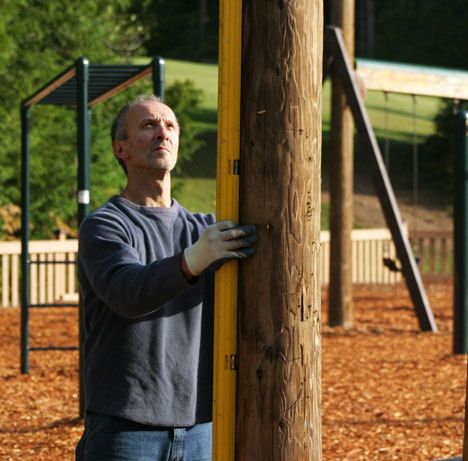When the refurbished Castle Park opens for business next spring, there will be something new for children and adults.
There’s a slider with a handle on ball bearings that allows kids to travel above the ground. Like, real fast.
Or a new rope pyramid that will challenge climbers of any age. And lateral bars for big folks who want to tone up while the children are exploring the venerable 18-year-old playground at Community Park.
“Everything we’re doing here is built to last,” said Mike Skouras of Langley’s Skouras Construction.
Last spring, the South Whidbey Parks & Recreation board of directors approved the final $162,000 to complete the process of replacing damaged or worn parts of the cedar playground with Fibreforce decking and framing of Trex, synthetic wood materials designed to weather the elements for 30 years.
“The sections with the most wear-and-tear are the ones being replaced,” said parks director Terri Arnold.
Following the parks district’s narrow bond vote of $1.6 million in February 2008, the board wrestled with what to do with the park. A total of $300,000 was budgeted for the project.
Built in 1991 with community volunteers, the structure had deteriorated over the years from weather damage and the cumulative effects of thousands of children at play.
Ideas included tearing down the structure and replacing it with a similar castle-themed playground made of recycled plastic and wood, repairing certain areas incrementally with Alaskan yellow cedar or even erecting a large roof to cover the whole thing.
But when several large sections of perimeter fence were found to be damaged last year, park officials decided to replace it.
“The new fence is made of Fibreforce, a cedar-toned composite resin that will be stronger and last a very long time,” said park maintenance supervisor Tom Fallon. “The lack of the perimeter fence was a safety issue we couldn’t ignore.”
Trex is a company that makes composite products from a combination of reclaimed wood and plastic fibers. Skouras said plastic shields the wood from moisture and insect damage, preventing rot and splintering. Wood protects the plastic from ultra-violet damage while providing a natural, attractive look and feel.
Name signs and other artwork have been sanded and sealed with a clear finish, so they’ll last for years to come.
“We’re saving or recycling as much of the original wood as possible,” Skouras noted. “The many termites and carpenter ants we’ve encountered are jumping ship because they can’t snack on plastic.”
The excess wood that can’t be used has been thrown into a nearby pile for people to examine and haul away.
Some find the surplus wood works well for small home projects.
“The pile started to grow, then the story got out and it just disappeared,” Skouras noted.
Nearby, Cedar Doctor Jeff Smith was using a drill to create a hole in a wooden upright support for boron rods.
The non-toxic rods, which look like clear glue sticks, detect moisture in the wood and wick it away.
Smith will make random checks over the next few years and replace the rods as required.
“This is a fairly new technology that began in Europe when it was realized that timbers in boron mines don’t rot,” Smith explained.
“It’s a simple fix for wood in wet climates. Which Whidbey certainly has.”
Skouras added that he hopes to be done by late January or February, depending on the weather.



